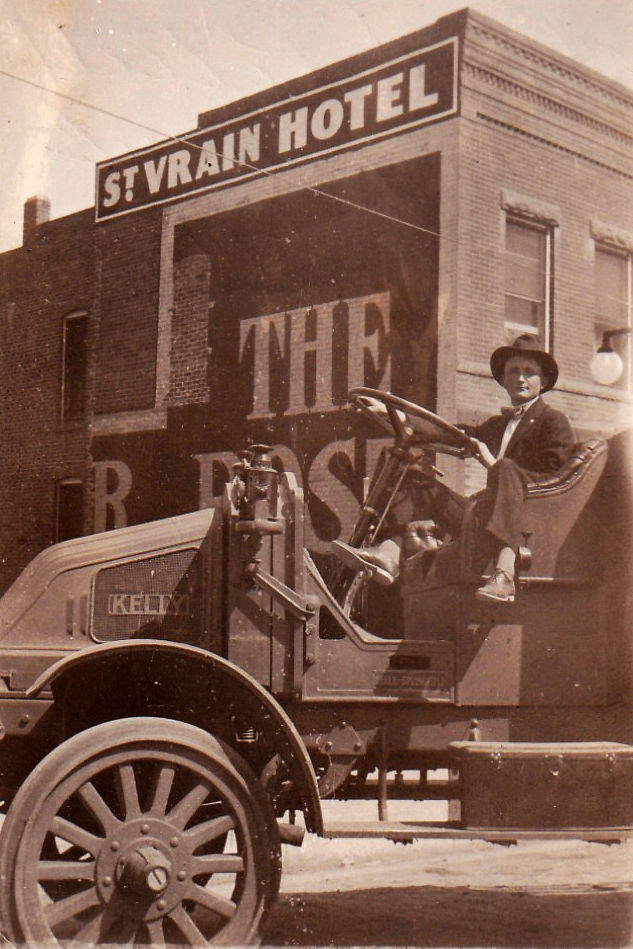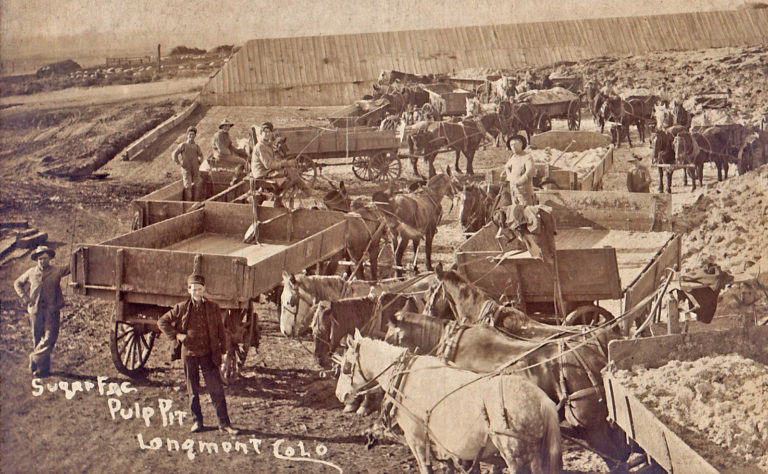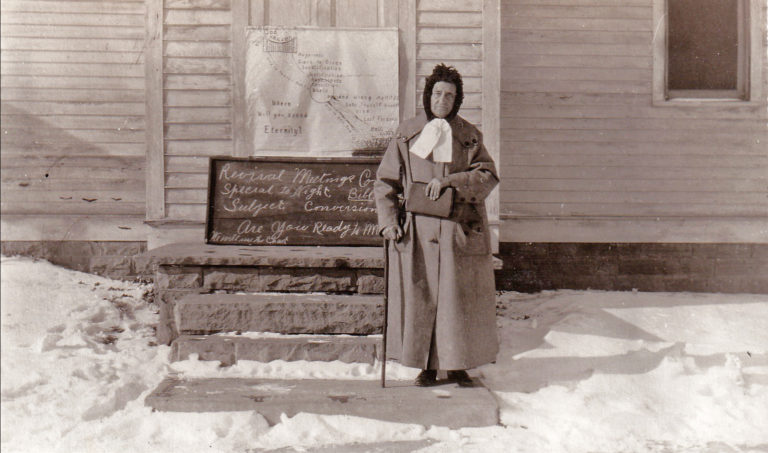Written on the back of this snapshot is: “Floyd Pettitt – Longmont – 1918.” The chances are good that the person referenced is actually Floyd Albert Pettett, who in 1918 would have been about 20 years old. At that time, Pettett was working as a pharmacy clerk for the Longmont Drug Company. If, in looking at the snapshot, one had to guess the occupation of the person sitting on the truck based on his clothing — i.e., suit, bowtie, white shirt and light-weight shoes — pharmacy clerk would be a much better guess than driver of an open-cab truck.
Until I saw this snapshot, I had never heard of a Kelly-Springfield truck (note the “Kelly-Springfield” name on the metal plate above the running board). It was built by the Kelly-Springfield Motor Truck Company in Springfield, Ohio, which was established by the Kelly-Springfield Tire Company around 1910. The truck was referred to by the company as “The Big Brother to the Railroads,” an odd claim given the power and size of locomotive engines. Its water-cooled engine gave it a distinctive-looking front end, quite different from vehicles we’re used to seeing with radiators in the front. For front-on views of these trucks see the following two links: 1) An undated photo taken in front of the Ford Motor Company factory in Detroit at Kelly-Springfield truck at Ford Motor Company factory | DPL DAMS (detroitpubliclibrary.org)
2) An undated photo of a fleet of Kelly Springfield logging trucks in Eatonville, Washington, at Fleet of Kelly Springfield Trucks (ca. 1923) – Eatonville To Rainier (You can click on the image to enlarge it). Note that most of the trucks in these photos have roofed cabs. One reader at the above logging truck site surmises that Kelly-Springfield sold the trucks with a cab and chassis, leaving it up to the owner/operator to modify the cab to suit their needs.
Sporting hard rubber tires, these ultra-practical work trucks would have given the driver and passenger a pretty hard ride! The truck pictured in the snapshot probably had a double chain drive, and its two headlamps probably burned oil. The load options available with these trucks probably ranged from 1 ½ to 6 tons. Kelly-Springfield manufactured these trucks into the late 1920’s.
Floyd Pettett was born in Broughton, Kansas, on June 13, 1898, to Emmet and Alice (Brown) Pettett, who were farmers. In the fall of 1921, Floyd married Florence Ruth Boulter, born in Illinois in 1903, in a ceremony held in Longmont. In October of 1927, Florence would give birth to their son, Locke.
On December 19, 1927, Floyd and three other men would be identified by the Longmont Daily Times as the rescuers of a young man who had been in a single-car accident the night before. The victim found himself pinned beneath his overturned car at the side of what the newspaper termed the Denver-Broomfield road. Floyd and the other three were able to lift the car enough to allow the victim to crawl out. The car had flattened him against the pavement, preventing him from even moving his arms, and had he not been rescued, he may have frozen to death. The young man, who wouldn’t give his name, got off with just a bloody nose.
Floyd would advance to the position of pharmacist with the Longmont Drug Company, and Florence would work as a bookkeeper for Longmont’s First National Bank. Their son, Locke, would graduate from Longmont High School in May of 1945, and, after a brief stint in the military, would enroll at the University of Colorado in Boulder. In November of 1947, his young life would be cut tragically short. He was apparently taking flying lessons at the time, for it was reported that he and his flight instructor were killed when their plane crashed southeast of Longmont’s Municipal Airport.
By 1955, Floyd and Florence had moved to Boulder, where Floyd was a pharmacist with Lutes Drug Store. Floyd and Florence would subsequently move back to Longmont, perhaps to retire, for that is where they were living when Floyd passed away in December of 1975 at age 77. Florence would pass away in Warrenton, Oregon, in September of 2020 at age 97.
The remains of Floyd, Florence and Locke are all interred at Mountain View Cemetery in Longmont.
The St. Vrain Hotel looming up behind Floyd was the second hotel with that name in Longmont. It sat (and the building still sits) at 240 Main Street.
The first St. Vrain Hotel was founded in the early 1870’s and sat at or near the southeast corner of what is now 4th and Main. Here’s a link to an 1872 photo of the place from the Longmont Museum Photo Collection: Archival Items Image | Longmont Museum | City of Longmont, Colorado (rediscoverysoftware.com). Note the “Colony Office” sign on the windows at the far left of the building. No doubt this was where business of the Chicago-Colorado Colony was transacted. The Chicago-Colorado Colony was an enterprise put together by Chicago businessmen in 1870 with the purpose of creating a town in Colorado. Selling memberships in the colony, they raised enough money to buy 60,000 acres of land, which would hold their new town and nearby farms. By 1871 they had built the town, which they named “Longmont,” after Longs Peak, which was so readily visible from the place. One of their greatest and enrichening achievements was the building of large irrigation ditches from the St. Vrain River to farm fields.
The original St. Vrain hotel was not a Shangri-La, at least not in the eyes of Isabella Lucy Bird. In 1872, Bird, a Scot, decided to strike out from her home county for a grand trip to Australia, Hawaii and the Rocky Mountains. By 1873, having toured her first two destinations, she was ready to explore the Rockies. In 1879 she would write a memoir about her travels in the West titled “A Lady’s Life in the Rocky Mountains” (the 1900 edition is accessible via Google Books – see first item under “REFERENCES” below), so we have a record of her impressions.
To reach Colorado, Isabella sailed from Hawaii to San Francisco, then took a train to Cheyenne. From Cheyenne she travelled by rail to Greeley, where she would spend her first night in Colorado – it was September of 1873. Her immediate goal was to visit Estes Park, so, with this in mind and in order to meet her travelling party, she first endured a day-long journey from Greeley to Fort Collins in sweltering heat, arriving their “sick and dizzy.” The next few days were an exercise in frustration. The guide for her traveling party seemed to be clueless as to how to get to Estes Park and repeatedly got the travel party lost. To top things off, during this ordeal she was thrown from her horse onto some cacti. They never reached Estes Park.
Defeated by this fruitless and painful effort to reach her desired destination, Isabella decided to forego her plan. Knowing colder weather was on the way, she set out for Denver. It was on her wagon trip south to Denver that she stopped off for a stay at Longmont’s St. Vrain Hotel to recuperate. She was not impressed. But before I provide her description of the St. Vrain Hotel, I’ll quote her description of her arrival in the newly born town of Longmont. Her description makes it clear that Longmont, not surprisingly, was far different from what it is today. About entering Longmont, she writes: “This is the ‘Chicago Colony,’ and it is said to be prospering….We first came upon dust-coloured frame-houses set down at intervals on the dusty buff plain…then comes a road made up of many converging waggon tracks, which stiffen into a wide straggling street, in which glaring frame-houses and a few shops stand next to each other.”
She then goes on to describe the St. Vrain Hotel:
“A two-storey (sic) house, one of the whitest and most glaring, and without a verandah like all the others, is the ‘St. Vrain Hotel,’ called after the St. Vrain River, out of which the ditch is taken which enables Longmount (sic) to exist. Everything was broiling in the heat of the slanting sun, which all day long had been beating on the unshaded wooden rooms. The heat within was more sickening than outside, and black flies covered everything, one’s face included. We all sat fighting the flies in my bedroom, which was cooler than elsewhere, till a glorious sunset over the Rocky Range, some ten miles off, compelled us to go out and enjoy it.”
Her experience with the St. Vrain took a turn for the better that evening. Eating dinner at the hotel’s restaurant, she fell into conversation with the hotel’s proprietor, the “jovial, kindly” Colonel W. B. Sigley. Having learned about her failed attempt to reach Estes Park, Sigley was able to put her in touch with two young men who had just checked into the hotel and could guide her to Estes. Proving her spark for adventure, she set out with the two men for Estes the very next morning. The two gents managed to get them lost a few times, but having been to Estes before, they eventually succeeded in reaching it. And a few days later Isabell would make a successful ascent of Longs Peak. Her memoir, which detailed her experience in the Estes Park area, would sell like hot cakes, especially in the eastern U.S. and Britain, and fuel an interest in wilderness travel and conservation.
Following a return visit to Longs Peak in November, Isabella would head back to Scotland. Six years later, the St. Vrain Hotel would be destroyed by fire.
The second St. Vrain Hotel, seen in the snapshot, was built in 1905 and, as noted above, was located at 240 Main Street. It was known originally as the Hatch Rooming House after proprietor Delzaberth E. (or “D.E.”) Hatch, who at some point in time decided to rename the place the St. Vrain Hotel.
D.E. was a music teacher and musician from Illinois. He married Gertrude M. Brewer of Fort Collins in 1899 in a ceremony in Denver, officiated by Gertrude’s father, a minister, and they later became parents of a daughter, Gladys. At one point in time, D.E.’s entire nuclear family – i.e., parents Wallace and Betsy and siblings Francelia and Emil — lived in Longmont.
Given how the hotel looms up in the background of this snapshot, I pictured it as being quite a large establishment. In actuality, it’s a modest, two-story building which now houses the St. Vrain Apartments. Here’s a link to a Zillow posting with pictures and information about the place: https://www.zillow.com/homedetails/240-Main-St-Longmont-CO-80501/2095712080_zpid/? According to Zillow, the building has 5,740 square feet of living space.
There are 44 images at the Zillow site, and three of them – i.e., #’s 42 through 44 – are of historical interest. #42 shows the building in the 1940’s; #43 shows D.E. with a brass band that was most likely put together and led by him (he is standing with the cornet at the far left); and #44 shows D.E. at far right with his parents and siblings.
Sometime between 1916 and 1920, D.E., Gertrude and Gladys moved to Pomona, California, and it is at this point in time that I lose the trail regarding the life of the St. Vrain Hotel. What’s marvelous is that this building, now 116 years old, is still in use.
REFERENCES:
- “A Lady’s Life in the Rocky Mountains” by Isabella L. Bird, 1900 edition, Google Books at https://books.google.com/books?id=F1oUAAAAYAAJ&printsec=frontcover&dq=isabella+bird&ei=Ru9tS4DCMIvklQSw97GBDQ&cd=3#v=onepage&q=isabella%20bird&f=false
- Bellman Family Tree at www.ancestry.com
- Colorado County Marriage Records and State Index, 1862-2006 at www.ancestry.com
- “Fleet of Kelly Springfield Trucks (ca. 1923),” Eatonville to Rainer at https://eatonvilletorainier.com/2012/01/fleet-of-kelly-springfield-trucks-ca-1923/
- “History of Longmont,” Longmont Colorado at https://www.longmontcolorado.gov/departments/departments-e-m/museum/collections/history-of-longmont
- “How Isabella Got Her Groove Back, in Longmont,” Observations about Longmont, Colorado at http://longmontian.blogspot.com/2010/02/how-isabella-got-her-groove-back-in.html
- Isabella Bird’s 1873 Visit to Rocky Mountain National Park,” Rocky Mountain National Park/National Park Service at https://www.nps.gov/romo/isabella_bird_visit.htm
- “Kelly-Springfield Motor Truck Co was established in about 1910 when the Kelly-Springfield Tire Company decided to enter the truck business…,” January 31, 2017, Just a Car Guy at https://justacarguy.blogspot.com/2017/01/kelly-springfield-motor-truck-co-was.html?m=0&template=default
- “Kelly-Springfield truck at Ford Motor Company factory,” Detroit Public Library Digital Collections at https://digitalcollections.detroitpubliclibrary.org/islandora/object/islandora%3A173774
- “KELLY-SPRINGFIELD TWO-AND-ONE-HALF-TON TRUCK—K-35 (Car), ” what-when-how In Depth Tutorials and Information at http://what-when-how.com/cars/kelly-springfield-two-and-one-half-ton-truckk-35-car/
- “Longmont, Boulder County,” Denver Mirror, September 14, 1873, Colorado Historical Newspapers Collection at https://www.coloradohistoricnewspapers.org/?a=d&d=DMR18730914.2.11&srpos=2&e=——-en-20–1–img-txIN%7ctxCO%7ctxTA-st+vrain+hotel+w+b+sigley+longmont——-0——
- Longmont City Directories, 1912 and 1916 at www.ancestry.com
- Homeister, Caplinger, Bell, Pettet Family Tree at www.ancestry.com
- “St. Vrain Creek,” Wikipedia at https://en.wikipedia.org/wiki/St._Vrain_Creek
- Untitled article, The Larimer County Independent (Fort Collins) date November 23, 1899, Newspapers.com at https://www.newspapers.com/image/588636153/?article=04786fc5-a645-4bad-be31-ddce3b3bfae8&focus=0.4959232,0.5211998,0.6448963,0.5875961&xid=3398
- World War I and World War II Draft Registration Cards (www.ancestry.com)
- Zillow 2020 listing for 240 Main Street, Longmont, CO, at https://www.zillow.com/homedetails/240-Main-St-Longmont-CO-80501/2095712080_zpid/
- “1919 Kelly-Springfield Truck – Flickr” at https://www.flickr.com/photos/dok1/27543297493
- 1920 Census (www.ancestry.com)




Glad to see your site up and running. Jack!!
Thank you, Jim. I so appreciate your interest and support.